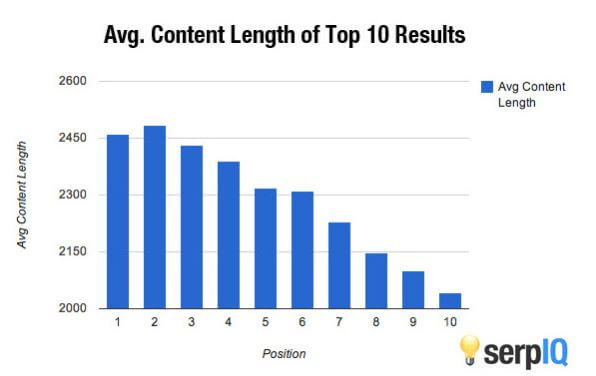Scrolling through web searches on Google on this subject, you’ll see numerous articles claiming they know the perfect length of content to improve your SEO, engagement, and number of shares on your articles. The correlation between long-form content is undeniable- there are many statistics showing that, in general, it will improve your ranking in terms of keywords on search engines, with a higher ranking the audience and engagement levels will, in theory, increase. Long-form content revolves around the idea that by providing longer, more detailed content to a reader, you will be perceived as more of an expert in your field; as David Ogilvy said, “only amateurs use short copy.”
The aim for all of this? Brand awareness. Whether you’re wanting to be a better known brand, or sell your products/ services, you need for people to be aware of your company, relate to it and desire what you’re selling.
There are, of course, arguments that shorter content is better; if your point can be made in 200 words, as well as it could be in 1000 words, then why waste a readers time with padded out sentences and waffle so that the writer can slip in a few more keywords? In March of this year, it was reported by the Telegraph, a goldfish can actually hold a thought for longer than a human at 9 seconds long versus our 8 seconds. Perhaps producing lengthy articles then, won’t be as productive to convey your message if it’s abandoned by a reader half way through instead of read to the end as a shorter piece may be.
Whilst the short content argument is something to consider, the benefits can’t be ignored, here are our top reasons we lean towards longer content when writing our blogs;
When content is the right content
With some subjects, such as those which are written on a B2B platform, articles are being read to answer a question; they’re there to provide help, guidance and a solution to a problem. If they’re being sought out by a reader, that said reader wants to find an article which will provide value to them, not just a breezy article. Sometimes content can get away with being short; we agree with the fact sometimes content doesn’t need to be long to get the point across. Perhaps then, we shouldn’t be putting a number on the word count and say hey- you’re writing the content, you’ll know if you can get the point across in 200 or 2000 words; write the length of content to make it right for you.
SEO
In the past few years the ‘ideal blog post length’ has steadily increased from the 500-700 mark upwards as now search engines and readers, want more well researched pieces to justify their loyalty to reading a blog. With this, remember we’re not talking about a longer piece riddled with keywords in order to get a higher ranking on search engines; their algorithms are so advanced, they’ll catch on, and your ranking afterwards will be poor. Google for example, changes is algorithm about 500 times throughout a year, and so to avoid being caught, produce quality and valuable pieces, and you will be rewarded by the search engines. You can see on the graph below (from serpIQ) that the average content length for the top 10 search engine results is high; with no exceptions, those that are ranking highly are those producing longer content.

Backlinks
Backlinks are important for a websites SEO due to the search engines often considering websites with more backlinks as more relevant in their results pages for search query’s. Of course, it isn’t so simple as to get as many backlinks as possible; it’s the quality of a link over the quantity. When the search engine calculates the relevance of the keyword, it looks at if a connection is a relevant one; a DIY how-to site linking to a DIY supplies & accessories site for example, would be a good quality backlink.
Relating this back to long-form articles, there does seem to be a link between the length of an article and the amount of backlinks it gains; the shares of the article depends on how valuable readers view it as. As this number of backlinks increase, be that a share from a social platform or another website referencing it, it can be very valuable in terms of boosting your website’s SEO.
Social Media
Now, we’ve got to mention social media! One of the best ways to make your content widely read is to create a viral or well shared post on social media; a hard task with so much content out there to be shared. However, the facts and figures do show that long-form content does out perform shorter length content in terms of shares and engagement on social media.
In fact, on social media itself, take Instagram for example, there are examples of long-form content. In relation to the normal caption length, some publications have more to say, which does seem to be a large factor in the high engagement levels. Of course this is not completely due to the caption but is also due to the image and the popularity of the brand, but it’s undoubtedly a large factor in the engagement as often it gives information behind the image. As shown below, the captions often highlight facts and figures that followers of the account may not have been aware of. All captions for their photos have these background stories which ensures high engagement in both likes but also replies in the comments to the issues raised.
The answer to this can, and will be, debated for years to come, because for all the facts and figures given, and despite our belief that longer content is more valuable in terms of SEO, as algorithms evolve and social sharing continues to change, the answer will also continue to advance. Perhaps Mark W. Schaefer, the Executive Director of Schaefer Marketin Solutions, has the right idea, of write what you know, and let that determine the length;
“A seemingly endless debate in the business world is short-form versus long-form content. Do we acknowledge the research that shows that long-form content is shared more or do we respect busy readers who have limited time and attention span? Here is another view: The story should determine the length. The length doesn’t determine the story! People from every generation still consume long-form content if the content is interesting and compelling. Don’t make the story conform to algorithmic standards. Let the story dictate the proper length. Instead of long-form or short-form, maybe we should aim for ‘right-form’ content.”






